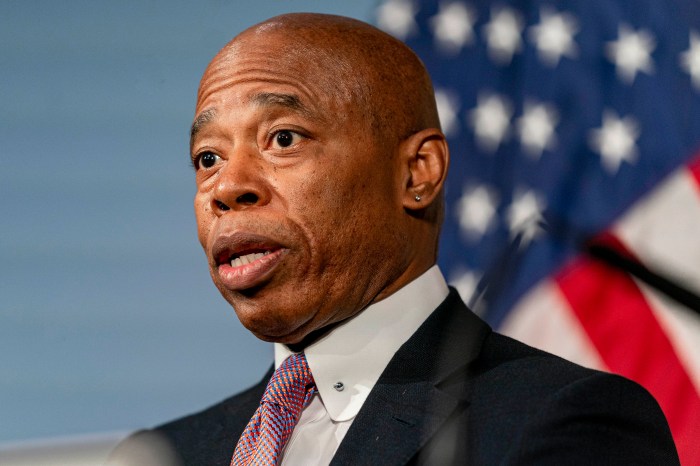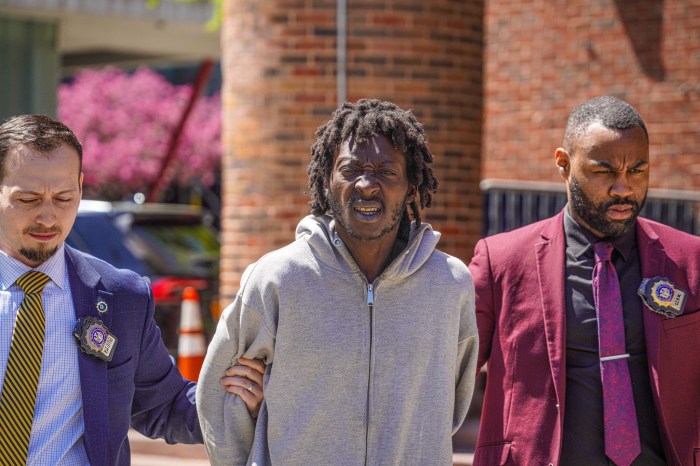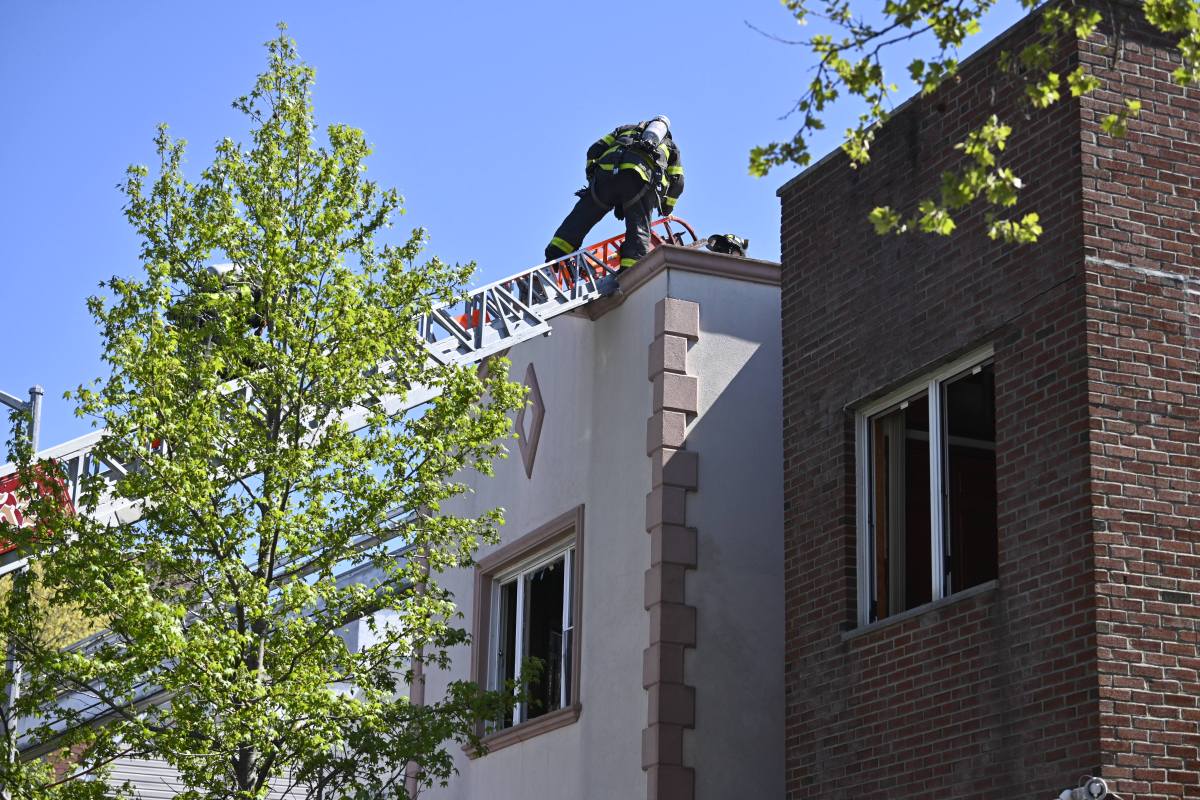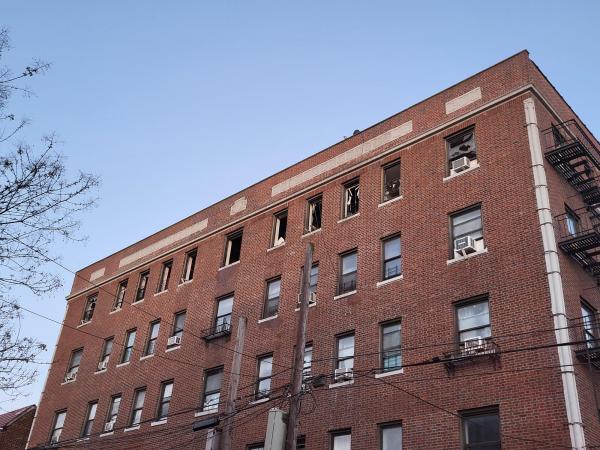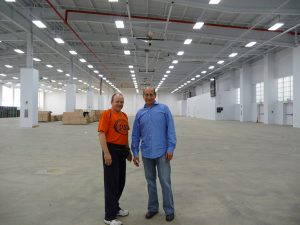 [/media-credit]
[/media-credit]
The nearly 70,000-square-foot facility is housed in a former city-owned warehouse at the tip of Montgomery St., just north of the Manhattan Bridge. The seven basketball courts are all on one floor — six regulation-size high school courts, 84 feet by 50 feet, and one shorter, “for older guys,” joked Radler. “But seriously, we want to put people in an appropriate division, so it’s competitive, not a blowout,” he said.
On three of the courts, the baskets descend to adjust to the group using it. The all-maple floor will lie on top of an environmentally friendly composite green play floor. The space can also be used for dodge ball, volleyball and six-on-six soccer. There are locker rooms, showers and bathrooms. On the balcony overlooking the courts is a beer-and-burger, sports-themed cafe equipped with TVs.
When Radler first responded to a request for proposals (R.F.P.) for the space in 1996, his proposal drew fierce opposition from community organizations from the Lower East Side, Chinatown and the East Village. Good Old Lower East Side (GOLES) and the Two Bridges Neighborhood Council insisted that Pier 36 be permanently dedicated for use by the community as a recreational facility, as promised in a 1994 memorandum of understanding by the city.
In a talking point in this newspaper’s March 24, 2011, issue, Victor J. Papa, president/director of Two Bridges, wrote, “The presence of the for-profit company on the pier is a promise denied to the Lower East Side community.”
In the early 1990s, the Dinkins administration planned to take over the pier and turn it into a parking lot and refueling station for city vehicles. Sheldon Silver, then a state assemblymember but not yet the Assembly’s speaker, led a successful lawsuit against the city, forcing it to create recreational space for the public through the R.F.P. process. Nancy Sparrow-Bartow, a member of Community Board 3, recalled that when Radler came along, there was only one other organization that responded to the R.F.P., “and no one came to do a community center, which takes a lot of funding and organization.”
At the board meetings, Radler was vetted intensively. A cadre of his supporters spoke on his behalf — local youths, single moms and people from nonprofits — who knew him from Pier 63, just north of the Chelsea Piers, which he had to vacate in September 2006 to make way for an extension of the Hudson River Park.
“Then there were a few people across the street, yelling we shouldn’t be here,” Radler said. “I understand I’m not going to make everybody happy, but if I can make a large percentage of people happy, that’s all we can try to do.
“I think what we had done historically at Chelsea Piers demonstrates that. I understand there are a lot of people who develop properties, make promises and then move on. I don’t consider myself a developer but a business operator. I’m here every day. We are hands-on.”
As a result of those meetings, Radler pledged to work with the Lower East Side Employment Network to fill jobs once the Pier 36 facility opens.
“We anticipate that it will go well,” said David Garza, executive director of the Henry Street Settlement, “but it is premature to comment on it.”
L.E.S.E.N. is a collaboration of the Henry Street Settlement, the Chinese-American Planning Council, Chinatown Manpower Project, University Settlement/The Door and GOLES. The organizations act as employment-service providers and share information about the local labor market, job orders and high-demand occupations and training needs. Garza credited C.B. 3 for being instrumental in helping the network become established.
“We cover a pretty good map on the Lower East Side,” said Garza. “It’s a unique model. We work together instead of competing, in true Lower East Side style.”
Basketball City will hire “in waves,” said Garza, as the need arises, for front-desk agents and maintenance workers, even coaches, although the latter would most likely be drawn from other sources.
“We expect between 20 and 30 people to be hired from the community,” he said.
Garza acknowledged that “certain subsets in the community have been overly concerned.”
GOLES organizer Emilie Rosenblatt complained they haven’t seen any movement for jobs yet at Basketball City. But Garza stressed that the project’s construction phase was never part of the hiring agreement.
“They have been very communicative, and we are optimistic we can build a good relationship with him,” Garza said, also noting that Radler did get a lot of public benefit in the deal.
The facility is being financed through the New Market Tax Credit, a federal program aimed to spur economic development in low-income neighborhoods. According to Crain’s New York Business, the city is contributing $2.7 million toward the cost of the facility’s heat, ventilation, electricity, plumbing and structural requirements — which will include solar panels, the composite wooden floors and energy-efficient lighting.
The city is reportedly charging Radler an annual rent of $150,000, plus a percentage of gross income above thresholds, for the 20-plus-year lease he signed with the city’s Economic Development Corporation. A few years ago, the community board and Speaker Silver asked the city to utilize some of the rent money from Basketball City to maintain the waterfront in that area. But the city said no, according to the Speaker’s office.
Radler calculates the project’s total cost at $12.5 million.
“When I took over the building, which belonged to E.D.C., it had no services, so I had to build from the ground up,” he said. “It’s taken a lot longer than I anticipated — and a lot more money.”
Radler has also committed to donating court time to schools and youth organizations in the neighborhood.
“There is a tremendous need for them to use the facility for practice and games,” he stated. “We feel there’s a benefit for kids to be involved in organized activities, so we are looking to run a free youth league and give out scholarships to our camps. They learn life skills, team building, how to account for their time. Studies show it’s better than free play.”
In addition, six-week clinics will be scheduled on Sundays for youths between the ages of 7 and 16 at a cost of $25.
“We want them to have ownership,” Radler explained. “When you get it for nothing, a lot of times, they don’t show. If they make a commitment, we get a better turnout.”
Top priority will be given to those living in Community Board 3 — the Lower East Side, the East Village and a section of Chinatown.
“But we don’t turn anyone away if they are in need,” Radler said.
However, in a phone interview, Papa said his neighborhood organization is “still concerned about a community that doesn’t have amenities for kids. And the way it’s being suggested now is that it be through schools, which doesn’t make it widely available to individual kids at times when they shouldn’t be on the street. We want a better deal, and not through academic institutions.”
Papa stressed things haven’t fundamentally changed since his talking point in this paper a year ago.
“We are still at odds with Basketball City, as many community people are,” he said. “And we feel that someday we will resolve those differences because they are willing to resolve them with us as well.”
But while Papa continues to call “foul” on Basketball City, not all see it that way.
Anne Johnson of C.B. 3 countered, “If Basketball City hadn’t come along, we would have lost the pier. It has taken years, but it was finally going to happen. I’ve known Victor Papa for almost 40 years and nothing he does isn’t for the benefit of Victor Papa: They were attacking us when they should have been spending their energies on some real problems on the Lower East Side, like raising money to organize over affordable housing and jobs,” said Johnson, a founding member of the Lower East Side People’s Mutual Housing Association.
She said people went over to the West Side and found out that Radler had a good track record when he was at Pier 63.
“We don’t want the waterfront gentrified,” Johnson stressed. “We don’t want a waterside cafe, with rich people coming down with chauffeurs. We want things affordable for the neighborhood.”
However, a former C.B. 3 member, who didn’t want to be named, is disillusioned with the outcome.
“The piers and waterfront are New York’s great resource,” the former member said. “They should be open to all New Yorkers. It’s a shame to privatize it. But Mayor Bloomberg is interested in revenue-generating entities. We should be able to fund public space with public funds.”
Radler said that 15 years ago, his original idea was to operate like a health club, but he saw that the model didn’t work.
“A lot of them failed across the country because it was difficult to generate revenue off-hours,” he noted. “I saw that organized activities and having a set schedule was successful.”
Like he did at Pier 63 in Chelsea, Radler will utilize the revenue generated from corporate clients to support programs for the community.
“We saw kids come back to us, now in the corporate world, who said how important it was for them,” he said. “It impacted thousands of kids and it impacted all of us. We did it because it was the right thing to do.”
The Basketball City president has already opened up the new facility for nonprofit fundraisers.
“It’s a big part of our mission to give back,” he said.
C.B. 3 board member Tom Parker, a retired high school teacher who still coaches softball, has volunteered to facilitate the place’s incoming Youth Development League. He has been using the assets of the community board, word of mouth and personal e-mail and has amassed pages of signatures of interested kids, schools and organizations.
“At 3 o’clock, they will have a place to go. We will have Madison Square Garden in our backyard,” Parker said. He speaks and writes Chinese fluently, which will be an asset in helping him coordinate the league.
However, GOLES doesn’t approve of Parker’s involvement.
“Tom Parker is a community member and doesn’t work for Basketball City,” Rosenblatt said. “The organization has plenty of resources to advertise their own programming — so why are they depending on community members, individuals, tenant associations and community groups to do their outreach? They should make their own fliers.”
Councilmember Margaret Chin met with Radler early last year to make sure he was working with the community board and community groups.
“We had meetings with all the tenants association presidents in the area, trying to connect local people to jobs,” the councilmember said. “From our vantage point, he has been a very open partner.”
“Basketball City is surrounded by subsidized and public housing,” Chin continued. “I think we are trying to foster an organized sports environment and make sure kids are active and come on a daily basis, which has more positive effects later on. I know some of the local schools are looking forward to this facility because of the lack of a lot of gym space,” she added.
Papa conceded, “I think, in the end, Basketball City is here. We’re here. We know they are our neighbors. We will approach them someday or they will approach us, I hope, and we will sit down and talk about it. Some time has to pass and some experience has to be accrued to reassess our relationship all over again. Right now, we like them, hope they like us and we get along.”
Silver, who was instrumental in obtaining the pier for the community almost two decades ago, is ready for the opening tip-off at Pier 36.
“I am very excited for the long-awaited opening of Basketball City, and I can’t wait to see some of my neighbors on the court, shooting hoops,” he said. “Basketball City will be an outstanding asset to our community, providing court time and recreational space for youth leagues, schools and others from the Lower East Side, Chinatown and the East Village.”
Radler is also anxious to get rolling.
“We believe Basketball City is going to help the waterfront, the community and New York City. I’ve got my eye on the ball,” he assured.
To sign up for youth leagues at Basketball City, e-mail Tom Parker at tomparker@rcn.com . For adult corporate leagues, contact Lee Isenstein, 212-233-5050, or e-mail Lee@BasketballCity.com .










